Customer retention rate is the percentage of people who make several orders from your online store. These people are your loyal fans, generating44% of total revenueand 46% of orders—despite only accounting for 21% of a brand’s customer base.
Loyal customers are clearly more profitable. They already know, like, and trust your DTC brand. The real question is: How do you turn more first-time buyers into your best customers?
Managing retention can feel overwhelming, especially if you’re a DTC operator looking to give existing customers personalized retention marketing at scale. This guide shares how to identify and improve your ecommerce customer retention rate, with a focus on retention emails.
- What is customer retention in ecommerce?
- What’s the average ecommerce customer retention rate?
- Customer retention stats and trends
- The best ecommerce customer retention strategies and tactics
- Customer retention email strategy: tactics and best practices
What is customer retention in ecommerce?
Customer retention rate is the percentage of people who make repeat purchases from your ecommerce store. If you sell to 10,000 people each month and 2,500 people return to make another purchase at some point in the next year, for example, your customer retention rate would be 25%.
Other metrics to benchmark your ecommerce customer retention include:
- Customer lifetime value(CLV):如果客户平均三个购买美元40 each, for example, your CLV would be $120. Use this to measure the effectiveness of retention strategy. An increase in CLV means even if the number of purchases someone makes doesn’t increase, it’s working—customers are spending more money with your brand.
- Customer or revenue churn:The percentage of customers who leave a business over any given period. Businesses in the consumer electronics industry have thehighest average churn rate, at 82%, but the lower, the better.
- Customer loyalty rate:The percentage of existing customers who join your loyalty program. People who join the program show an intention to buy again—even if they haven’t made a second purchase yet.
- “Retention is about revenue. Sure, you could think about acquisition when you think about revenue. ‘How do we bring more customers in to combat the customers we’re losing?’ And you’re right, that’s a piece of the puzzle. But if you only focus on getting new customers, giving little thought to the ones you’ve already attracted, you’re missing a giant piece of the puzzle. More DTC brands could benefit from putting as much focus on retention as they do on new customer acquisition.” —Val Geisler, customer advocacy lead atKlaviyo
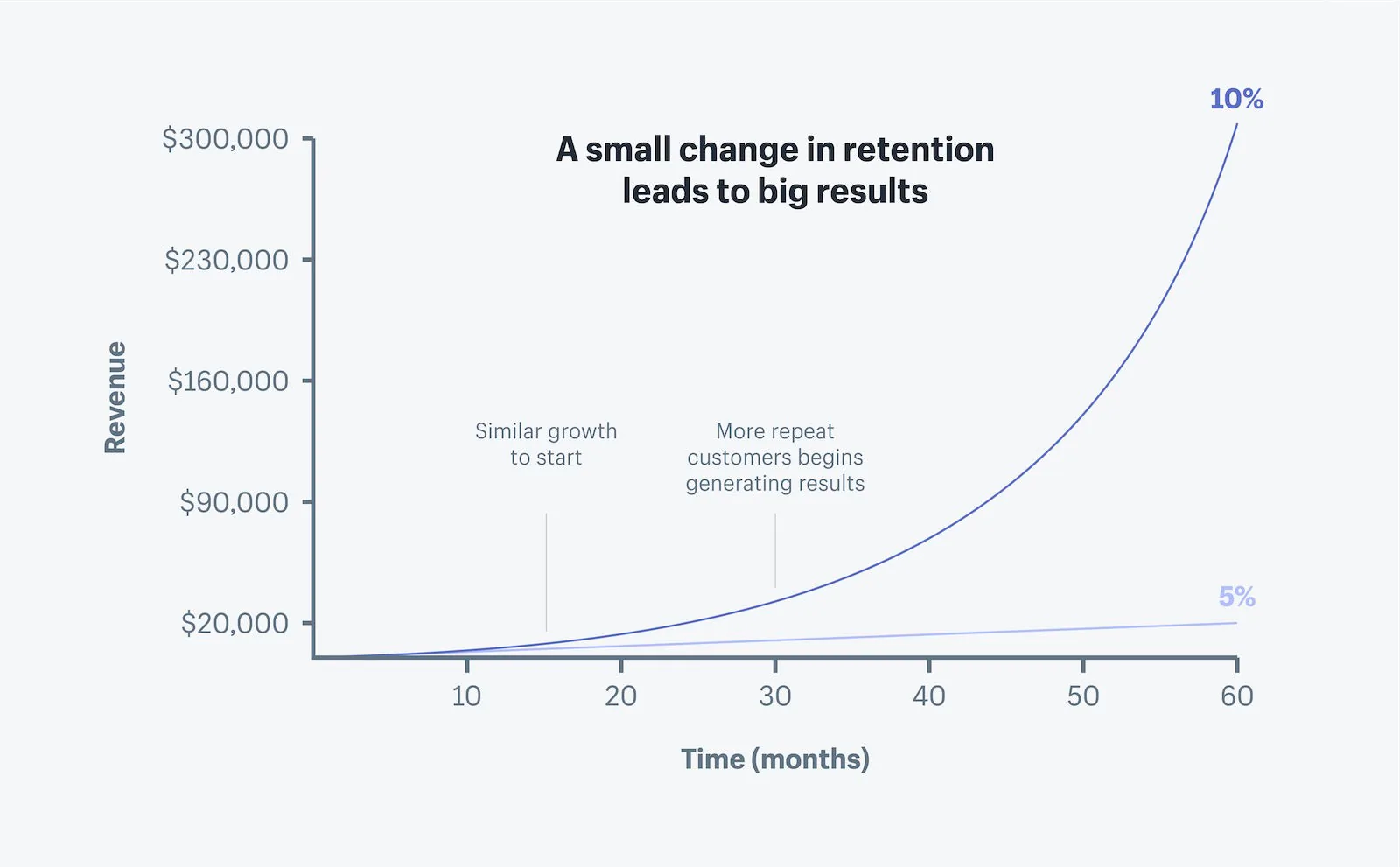
What’s the average ecommerce customer retention rate?
Data showsthat online retailers have an average repeat customer rate of 28.2%. However, this differs by industry:
- Cosmetics: 25.9%
- Apparel: 26%
- Supplements: 29.1%
- Coffee 29.6%
- Pet products: 31.5%
According to Moran Khoubian, Senior Director, Ecosystem & Community atYotpo, “Average ecommerce retention rates differ based on industry, size, and business model, but they typically sit somewhere between 15% to 30%.
“因为这是一个相当wide range, we recommend brands measure retention by more specific metrics, including customer lifetime value, repeat purchase rate, average order value, average purchase value of loyalty redeemers versus non-redeemers, and time to second purchase.”
Moran adds, “Shifting focus toward retention leads to improvement across these KPIs, leading to higher overall retention rates.”
Customer retention stats and trends
Retention combats skyrocketing customer acquisition costs
每天都有新的网上商店出现。欧宝体育官网入口首页Combine that with social media platforms pushing retailers into a pay-to-play model, and it’s no wonder why Ben Jabbawy, founder and CEO ofPrivy, says “Some brands are seeing ad costs go five times higher than [before] to drive the same amount of traffic.”
We’ve all seen the data: it’sfive times cheaperto retain an existing customer than acquire a new one. By shifting your focus toward retention, you combat ever-increasing acquisition costs and increase profits.
Eli Weiss, senior director of CX and retention at琼斯路Beauty, says, “Up until recently, success of consumer companies was measured by how well they can use the Facebook ads arbitrage system. If their CAC was low, they could earn and churn customers to success, because each order was profitable.
“AsiOS 14 rolled outand paid acquisition became a highly competitive space, investors are looking at CAC to LTV ratios, and businesses are learning that retention is not just about squeezing more money from current companies, but rather a somewhat direct route to creating brand evangelists and superfans.”
Embed retention in community
Strong affinity with your product isn’t always enough to improve retention, especially with new competitors emerging every day. One thing a competitor can’t beat you on, however, is your community.
研究显示that communities increase customer retention and decrease customer support costs. It’s whybrands will invest morein customer loyalty and connection than almost any other customer acquisition and retention strategy over the next year.
Some brands have yet to even explore digital marketing or paid advertising because their community is so strong. They spend so much time [building] it that it drives the direct-to-consumer revenue.”
—Kimberly Smith, Founder, Marjani and Board of Directors, National Retail Federation
To build a community your existing customers want to stay connected with, define your purpose and have a shared vision that knits your community together. Position it as an exclusive club; a group of likeminded people who talk about the topics they’re interested in. Your products should naturally weave into those conversations.
Superplasticis one brand capitalizing on NFTs. Its president, founder and CEO, Paul Budnitz,says he has plansto build a brick-and-mortar store: “At certain times, you’re not going to be able to get in unless you’ve got one of our NFTs or tokens in your wallet.
“It’s the same thing with our website. There will be exclusive entry, things only you are able to buy. Because if you’re willing to make a commitment and join in with us, then we’ll make a commitment back to you.”
Hire a retention team
Community management alone is a mammoth task. Instead of dividing the task between customer support and marketing teams, give your all to community-building by employing a specialist retention team.
Val Geisler, customer advocacy lead at Klaviyo,tweeted, “Seeing more and more brands taking retention seriously and hiring for it in-house. [I] LOVE this movement and I guarantee this will be a table-stakes role in every growing ecommerce company in the next 2-3 years.”
The best ecommerce customer retention strategies and tactics
Define your ideal customer
Customers are unlikely to make repeat purchases if they’re not getting value from the product.
让你的营销和保留团ob欧宝娱乐app下载地址队在同一page. Build accurate buyer personas—based on data, not assumptions—to figure out the type of person most likely to enjoy your product. Execute marketing campaigns that speak to that specific persona.
Retention works hand-in-hand with CX and Growth to ensure we are acquiring customers who would like our brand, so retention is an easier battle to win.”
—Eli Weiss, senior director of CX and retention at Jones Road Beauty
Let’s put that into practice and say sales data shows people aged 60-plus and those in the 20–25 age demographic have similar conversion rates. However, those aged 60-plus have a 7.8% retention rate (compared to 3.5% for the younger segment).
It makes sense to refine your marketing messaging, imagery, and targeting to reach the older demographic. They’re the segment less likely to leave after making a single purchase.
Merge customer data in one platform
From inventory management systems to your email marketing platform, there’s awealth of data to tap intowhen fixing a customer retention problem.
According to Yotpo’s Moran Khoubian, “The most impactful retention strategies are built on shared data between a brand’s tech stack, so your brand has a 360-degree view of every single customer—what they like, what they don’t, when and what they purchase, who they are, and more.
“Use a platform that connects your marketing solutions out of the -box, or enables integrations between your tech solutions in the back end, so that way your team can focus on building better, more personalized experiences for every shopper.”
Popular options that sync with your Shopify store include:
Pay close attention to tools that combine data in almost real time. Things move fast—customer demand can change overnight. Direct integrations with your most-used apps will prevent you from missing important retention insights.
Meet customer expectations
The strategy you use to improve customer retention doesn’t have to be anything groundbreaking. Start small and get the basics right.
According to Eli Weiss, senior director of CX and retention at Jones Road Beauty, “When a customer buys something online, you need to ensure their reality meets the expectation you are selling.”
Eli shares the mistakes brands often make throughout this process:
- Selling something that does not exist (i.e., promising too much)
- Selling shipping time that is not guaranteed (for example, brands promise free 2-day delivery and it takes 4–6 days)
- Selling more product before customers see any ROI from their original purchase (i.e., cross-selling before the product even arrives)
Transparency is a double-edged sword. Not only does it improve customer retention, but it could help attract more customers less likely to leave after an initial purchase. Research from Shopify’sFuture of Commerce reportshows 45% of shoppers are actively looking to shop from businesses that clearly show anticipated delivery times.
Above all, make sure you can keep the promises you make to customers. If there’s a risk that shipping times could be thrown off, buffer some extra time into your delivery timeframes. It’s much better to meet expectations than let someone down.
“Send customers messages about their orders, including order confirmations, shipping updates, subscription notifications, delay notifications, and more, to ensure they’re aware of every step of the fulfillment process. These kinds of communications, especially when done via a personal channel like SMS, are essential for building trust and keeping customers coming back, even if delays do occur.” —Moran Khoubian, Senior Director, Ecosystem & Community atYotpo
Surprise and delight loyal customers
Once you’ve met a customer’s basic expectations, go one step further with unexpected surprises. Some94% of customerswho received a surprise gift felt more positive about the company. It’s those happy customers who are less likely to churn.
“An unexpected but thoughtful gesture can go a long way to ensuring your customers feel loved and appreciated. A free gift, handwritten thank you note, or generous discount on their next purchase are easy to implement.” —Kurt Ellis, president ofGLF E-Commerce Fulfillment
Run Gum, for example, surprises new customers with its packaging. People receive a handwritten note in a custom mailer. There’s also a direct line to the customer support team, should first-time customers need help with their order.
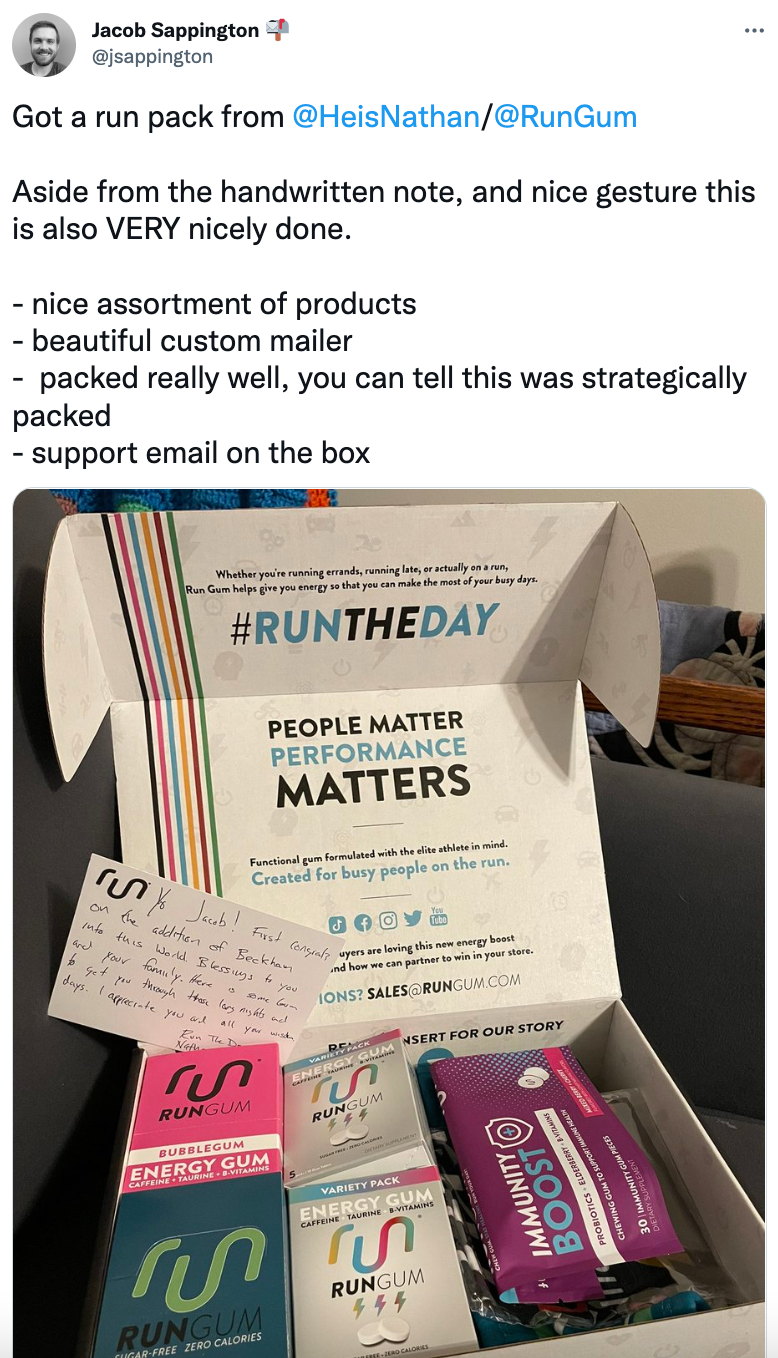
The best part? These surprises can remain inexpensive as you scale. Divide the responsibility of handwritten notes between your customer support team so one team member doesn’t get loaded with the burden. Or, use email automations to surprise new customers with a discount code to redeem on their next purchase.
Support a cause or mission
There are likely other competitors selling a comparable product at a similar price point. But customers chose you. Dig deep into why and pull on it in your customer retention strategy. For most people, that’s a shared cause or mission.
Data compiled in theFuture of Commerce reportshows:
- 77% are concerned about the environmental impact of the products they buy
- Nearly half of customers chose to buy from brands that have a clear commitment to sustainability
- Sustainable practices elicit emotional responses, which have been proven to result in a 306% higher customer value
According to Bill Glaser, CEO ofOutstanding Foods, “Companies that advertise their social contributions often experience higher customer retention rates because they know that their shopping habits benefit others.”
Outstanding Foods puts this into practice through its partnerships with Snoop Special Stars and the Maryland Food Bank. Bill says, “Customers know that when they shop with us, they help provide food and finances to individuals in need and outstanding charities. Customers will remain with companies that involve them in their social mission.”
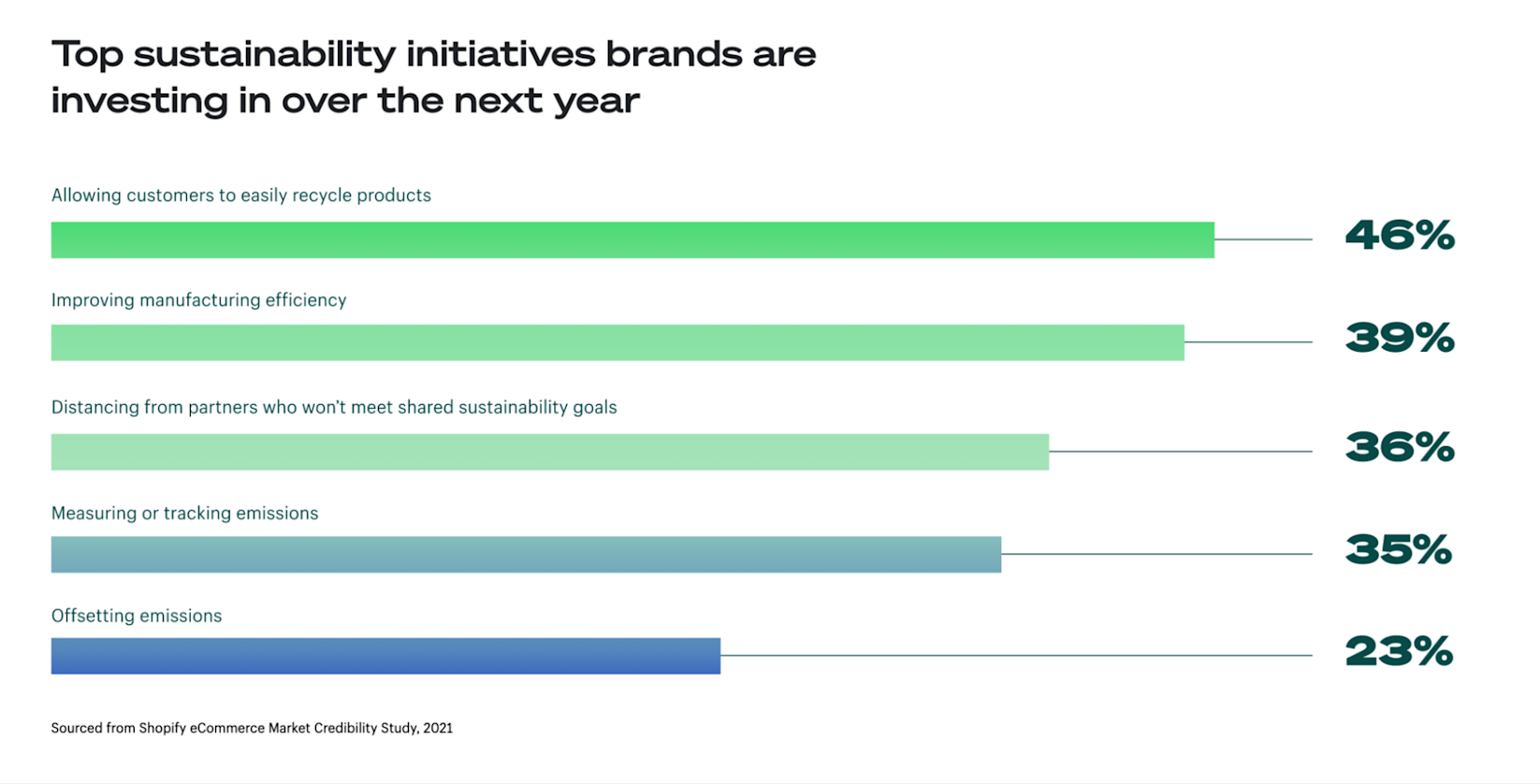
Host fun product-usage challenges
As we mentioned earlier, customers are at a higher risk of leaving if they don’t get value from your product. That’s easy to do if the product sits unused.
Host a fun product-related challenge to get customers actively using your product and sharing it with others. That could be:
- A cooking challenge using your ingredients
- A fitness challenge using your workout clothes
- A monthly goal-setting challenge using your journal
Take it from Slater McLean, co-founder ofOliver Charles. The brand reduced its customer retention rate from 20% to 5% by convincing first-time customers to join a challenge: “The 1-Week Challenge encourages our customers to wear our product every day for a week straight. If they do it and send us a photo each day, we refund them $50.
“This incentives customers to fully experience the value our product offers,” Slater says. “Those who complete the challenge are 50% more likely to return and buy more sweaters.”
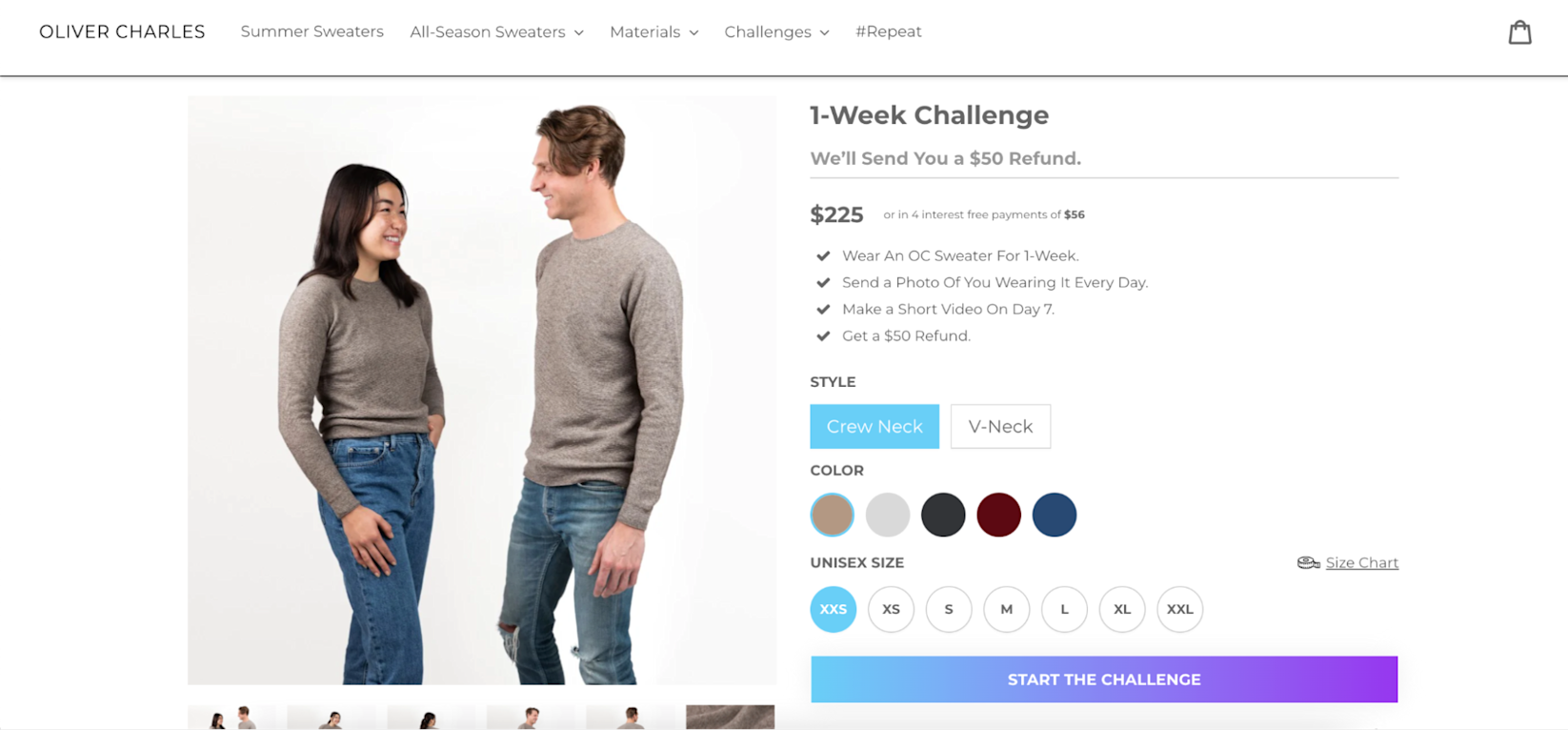
Use dunning management software to avoid subscription churn
Research shows three-quarters of ecommerce businessesplan to offer subscriptionsby 2023, largely because they give scaling businesses sustainable revenue. Subscriptions also lend themselves to customer retention: once someone signs up, they’re authorizing the brand to make repeat purchases on their behalf.
Pet Joyis one DTC brand taking advantage of the subscription boom. However, its vice president, Jeffrey Petett says, “The main word internally these days is involuntary churn; losing customers not because they canceled, but because the credit card didn't bill. For us, that’s about 13% of our monthly customers, and 28% for the yearlies.
“Most of the things we do, like sending out emails, don’t really affect that, since a credit card is going to bill or not—it doesn't matter about the customer. We noticed that by retrying the customer every Friday for the next few weeks, we could get back about a quarter of them.”
Minimize this problem—and therefore, improve customer retention—with dunning management software. The following tools will automatically notify customers who need to update a soon-to-expire payment card:
Customer retention email strategy: tactics and best practices
Eight in 10 businessesuse email marketing for customer retention. Why? Because it gives you a direct line of communication with your current customers. Some80% of the US populationuses email—and many of them are open to receiving marketing emails from brands.
But the email marketing strategy you’re using to acquire new customers isn’t the same strategy you’d use to retain existing ones. Your current customer base likely already knows, likes, and trusts you. They’re at the bottom of the marketing funnel and need to receive a different type of content before they’re ready to buy again.
Here’s how to build an engaging customer retention email strategy.
Check in post-delivery
Your job isn’t over once a shipment leaves your warehouse. Things can go wrong in the delivery process, from delayed shipping to inventory damaged in transit. Customers rarely blame the courier. Your brand will bear the brunt of their dissatisfactory shipping experience.
Richard O'Connor, director ofFirst Mats, agrees that you need to get the basics right when improving customer retention: “Was the order dispatched quickly? Is it well packaged? Do you give your customers a tracking number? Some of the most important parts of the user journey happen after they have paid for their order, and getting these wrong will ruin any chance of them ever coming back to you.
“To see if you’re getting this right, schedule an automated follow-up email a few days after delivery that asks the customer about their shopping experience with you. This should just be a simple email from an individual, rather than a generic info@domain.com, with no offers or pictures.
“The lessons from your customer’s responses can be a game changer for your business that ultimately lead to better retention, more reviews, and more revenue.”
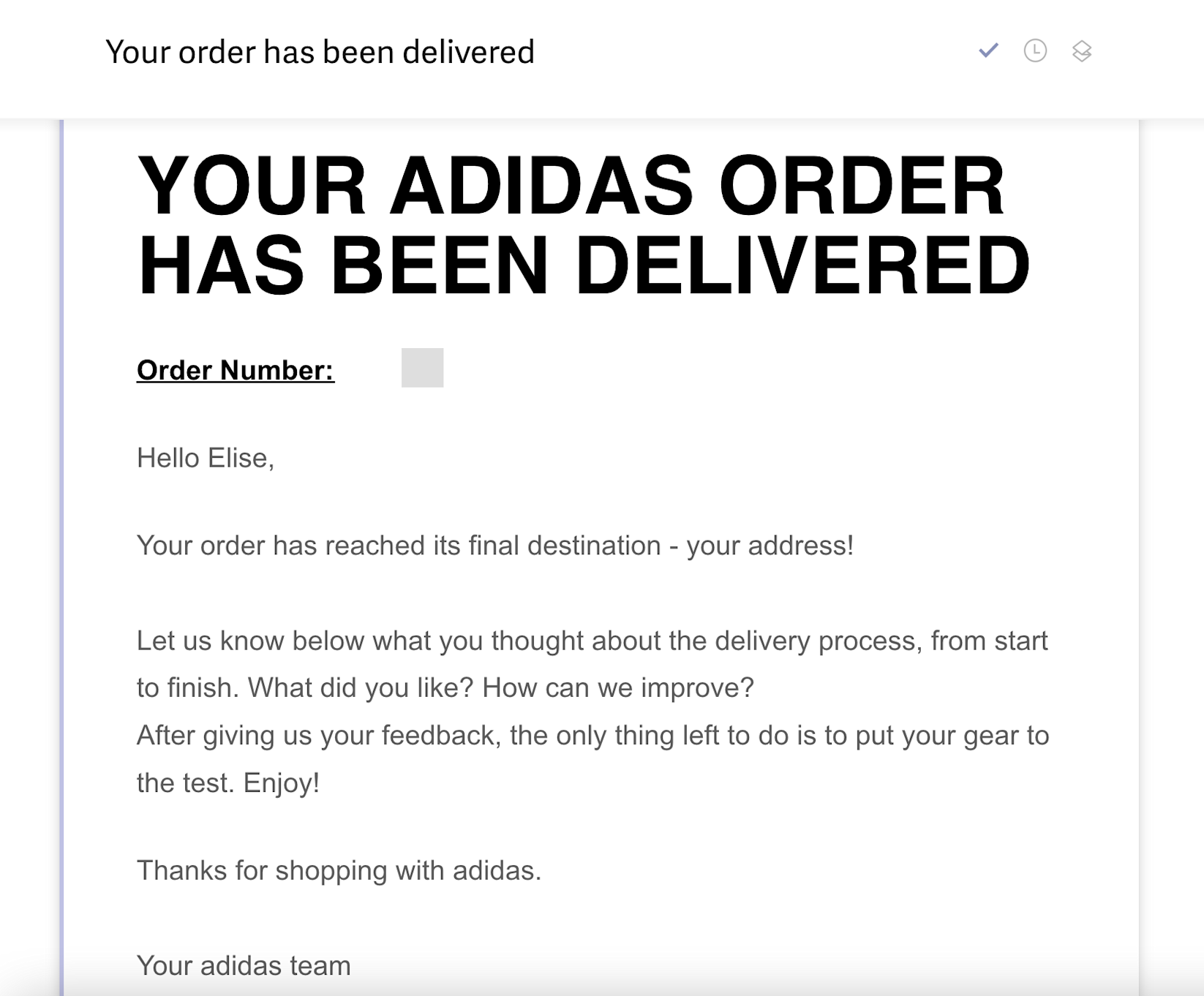
“The point of automating an email like this,” Richard says, “is that the customer either has a great experience and you’re building a positive relationship with them that can result in more orders, or, if they’ve had a poor experience, you’re opening the door for them to speak to you so it can be resolved before they have to complain using your website’s contact form or, worse still, leave a negative review.”
The timing of these emails is crucial. The last thing you want to do is check in with customers before their first purchase has been delivered.
Use a tool like惊叹to solve this problem. It’ll pool customer data (including delivery times) and time your automated email campaigns. Customers will only receive post-delivery check-ins once their parcel has been delivered.
Schedule emails around repeat order dates
It doesn’t make sense to recommend a product that someone has just bought. Analyze customer data purchase frequency to figure out when customers make repeat purchases. Use that insight to schedule emails around repeat order dates.
If you’re selling skin care, for example, your data shows previous customers run out and restock six months after the initial purchase. In the run up to that six-month date, you run the following automated series of emails:
- 4.5 months after initial purchase:Educational content around creating a skin care routine (featuring the moisturizer they’ve bought)
- 5 months after initial purchase:Upsell your more expensive moisturizer
- 6 months after initial purchase:Cross-sell other related products, such as face masks or cleansers
- 6.5 months after initial purchase:Promote your subscription boxes which contain smaller versions to try new products
- 7 months after initial purchase:Last-ditch sales attempt with a discount code to redeem on the moisturizer they previously bought
Remember to exclude people from the email series once they’ve made a purchase. The last thing you want to do is over-promote products they’ve not shown any interest in since their initial purchase date.
“If you had a beverage company, send surveys or look at order data to understand how many days a customer takes to finish consuming your product. Then send an email asking them to buy more that many days after the product has been delivered.” —Slater McLean, co-founder ofOliver Charles
Clive Coffee, for example, sends this email after a subscriber purchases its coffee beans. It offers a 20% coupon code to redeem on their next purchase. There’s also a carousel of related products—such as coffee machine cleaning products and coffee subscriptions—to encourage another purchase, even if they haven’t used up their previous product.
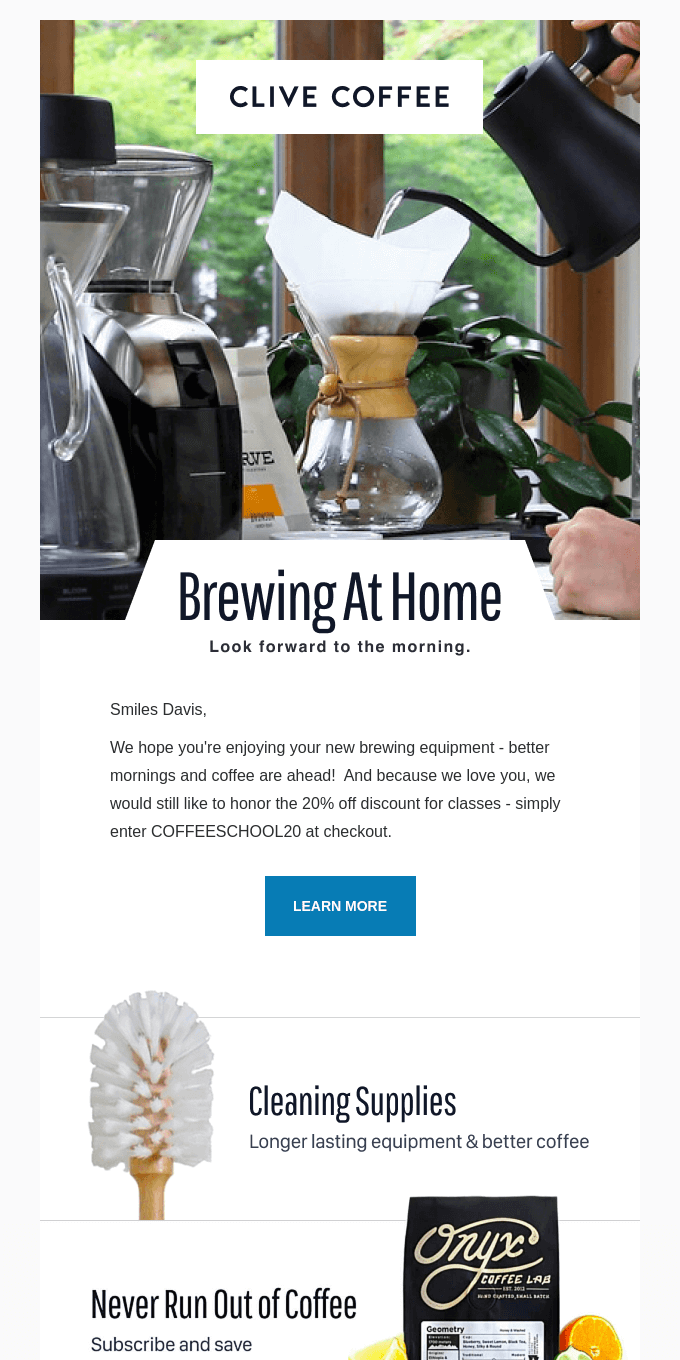
Offer a Skip This Shipment button for subscriptions
The subscription model is a great way to secure recurring revenue for your DTC brand. But there are often reasons why a customer might want to pause their subscription, such as:
- They’re going on vacation and won’t need their meal prep box
- They still have products left over from their previous delivery
- They’re between jobs and can’t afford the subscription box that month
In your upcoming subscription reminder email, give them the option to pause this in-email—rather than canceling their subscription altogether.
For consumable brands on Recharge, we saw a drop off when [customers] didn’t need more product. Instead, we created a Skip This Shipment” button that was one click from our Klaviyo emails. That made it easy for people to delay or skip their shipment, much like Amazon.”
—Carolyn Lowe, CEO and founder ofROI Swift
Funk It Wellnessis one DTC brand using this customer retention email strategy. Three days before a customer’s subscription is set to renew, it sends an email containing a “ship” or “skip” option. That way, people don’t get frustrated when they’re billed unexpectedly for a product they didn’t need. They can also skip a box without canceling their subscription altogether.
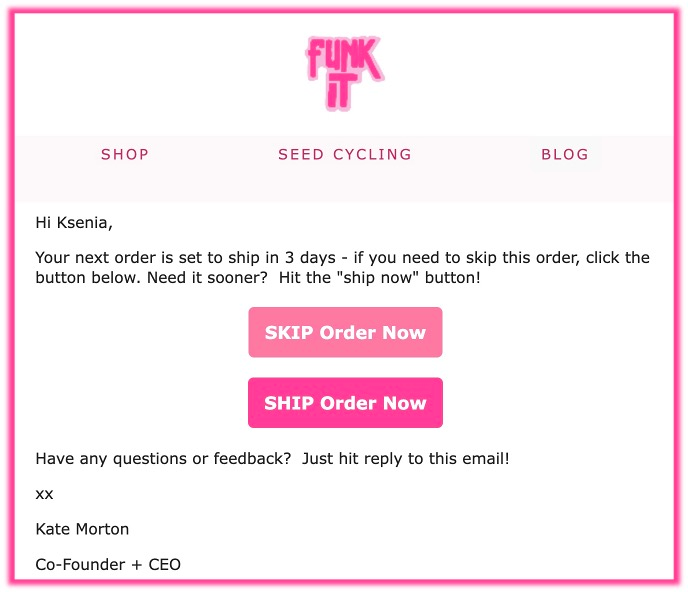
Promote a loyalty program
“Loyalty programs provide brands with abundant data on their loyalty members, especially when compared to new customers—think purchase history and frequency, favorite products, rewards redeemed, and more,” says Yotpo’s Moran Khoubian.
“As a result, brands don’t have to guess what these loyal customers want; they already know and can predict their buying habits accordingly.
“With this information from a loyalty program, brands can create experiences that engage customers exactly when they should be re-engaged—and on their preferred channel, whether it’s SMS, email, etc.— and they can know when they’re most likely to buy again, or if they’re at risk of churning.”
For example,Crate & Barrel Singaporepartnered withOverdose, a Shopify Plus Agency Partner, to launch a new ecommerce website. The retailer integrated its rewards program through the new storefront. Customers earn points by creating an account, sharing data with the brand (such as their birthday), and talking about the retailer on social media.
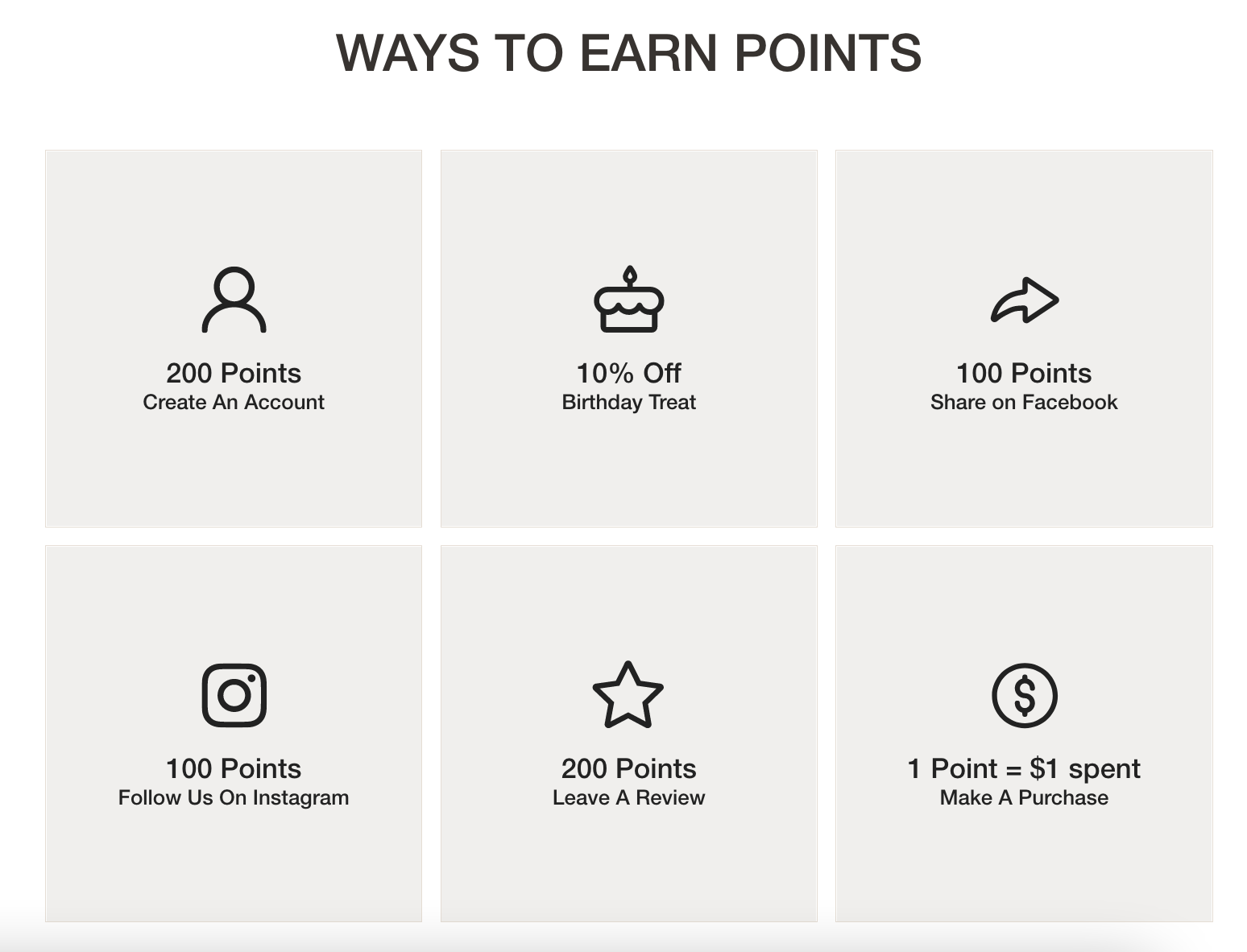
“The early signs are promising, and we have seen a 350% average increase in new sign-ups for our loyalty program,” saysCrate & Barrel Singapore’sbrand manager Stephen Wright. “This is a direct result of people engaging more with our loyalty platform, which is available both offline and online—a direct benefit of switching to Shopify Plus.”
Build your own ecommerce brand loyalty program, complete with rewards your customers will want to earn, using Shopify apps like:
For an even higher customer retention rate, expand on your loyalty program with a tiered rewards system. Give customers something to work toward—bigger and better discounts, perks, or freebies that keep them around after they’ve earned the first reward.
A loyalty program creates impactful customer experiences that keep shoppers coming back, even through economic uncertainty.”
莫兰Khoubian、高级主管、生态系统和通讯unity at Yotpo
Combine email with SMS
Marketing emails have an18% open rate. Some 90% of SMS campaigns, on the other hand, areopened within three minutes.
Get a customer’s phone number throughout the checkout process and ask them to opt into SMS campaigns. You’ll have a more direct line of communication with your customers, hence why96% of marketersusing text messaging say it’s helped them drive more revenue.
一旦客户选择成短信活动,发送文本messages that encourage them to make a repeat purchase. That could be:
- New product alerts
- Subscriber-exclusive flash sales
- Invitations to join your loyalty program
- Discounts on their favorite products
- Related items that work with those they’ve already bought
Moran Khoubian, Senior Director, Ecosystem & Community at Yotpo, says, “With SMS, brands can send very specific texts, including customer win-back campaigns, post-purchase review requests, and loyalty messages that leverage customer data, like their points balance, VIP tier, and rewards eligibility.
“Personal messages like these extend the conversation between brand and consumer and bring added value with every interaction.”
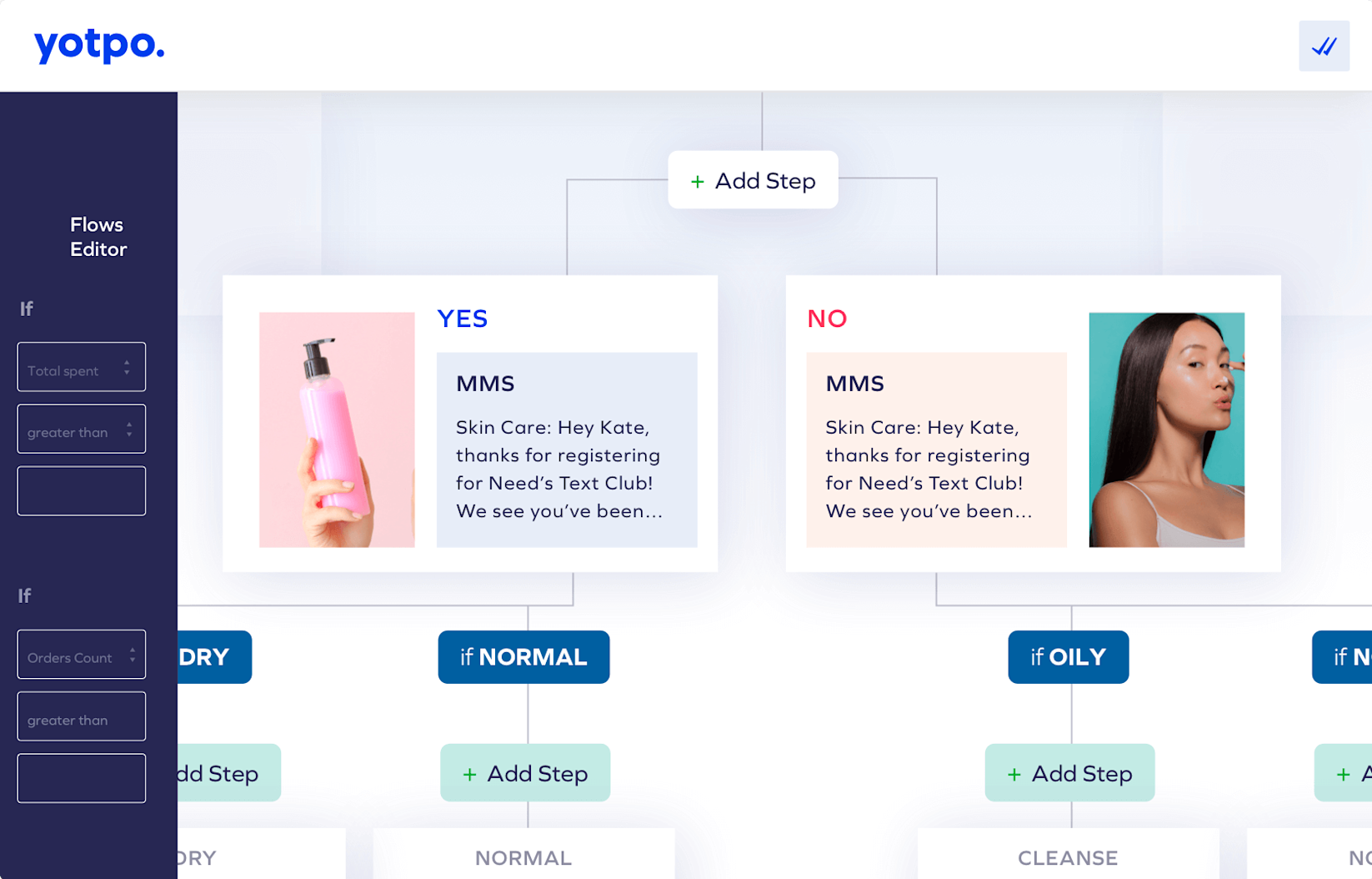
According to Moran, brands usingYotpo SMSBumptypically see:
- 66%+ conversion on user-generated content collections from SMS review requests in comparison to email
- 11%+ conversion on SMS win-back messages targeting inactive customers at the optimal time
TakeBushbalm, for example. The retaileruses SMS marketingto re-engage previous customers. Subscribers receive a “flash sale” notification—a discount code that’s exclusive to people on the list. There’s also a direct link to the product on show, removing friction and making it easier for them to buy.

How Shopify can help
Shopify Plus businesses have a range of tools to improve customer retention. That includes:
- Shopify Flow.Build custom workflows that re-engage existing customers based on data you already have about them, such as actions they’ve completed or products they’ve bought.
- Yotpo.An ecommerce marketing platform that turns first-time customers into loyal fans. Manage SMS campaigns, run loyalty programs, and personalize email campaigns by pulling data from your Shopify store into Yotpo.
- Klaviyo.Build automated email campaigns using sales data. Used by 65,000 Shopify businesses, Klaviyo uses predictive analytics to identify customers most likely to churn—so you can remarket to them before they zone out.
- Smile.Create a customer loyalty program with tiered rewards that incentivize existing customers to stick around. You can even integrate other Shopify apps and reward people for leaving reviews, donating to a nonprofit you support, or subscribing to your SMS list.
- RAPP.Instantly see your most important customer retention metrics, such as churn rate and CLV, within RAPP’s Shopify dashboard. This single source of truth can help you track whether your strategy is working.
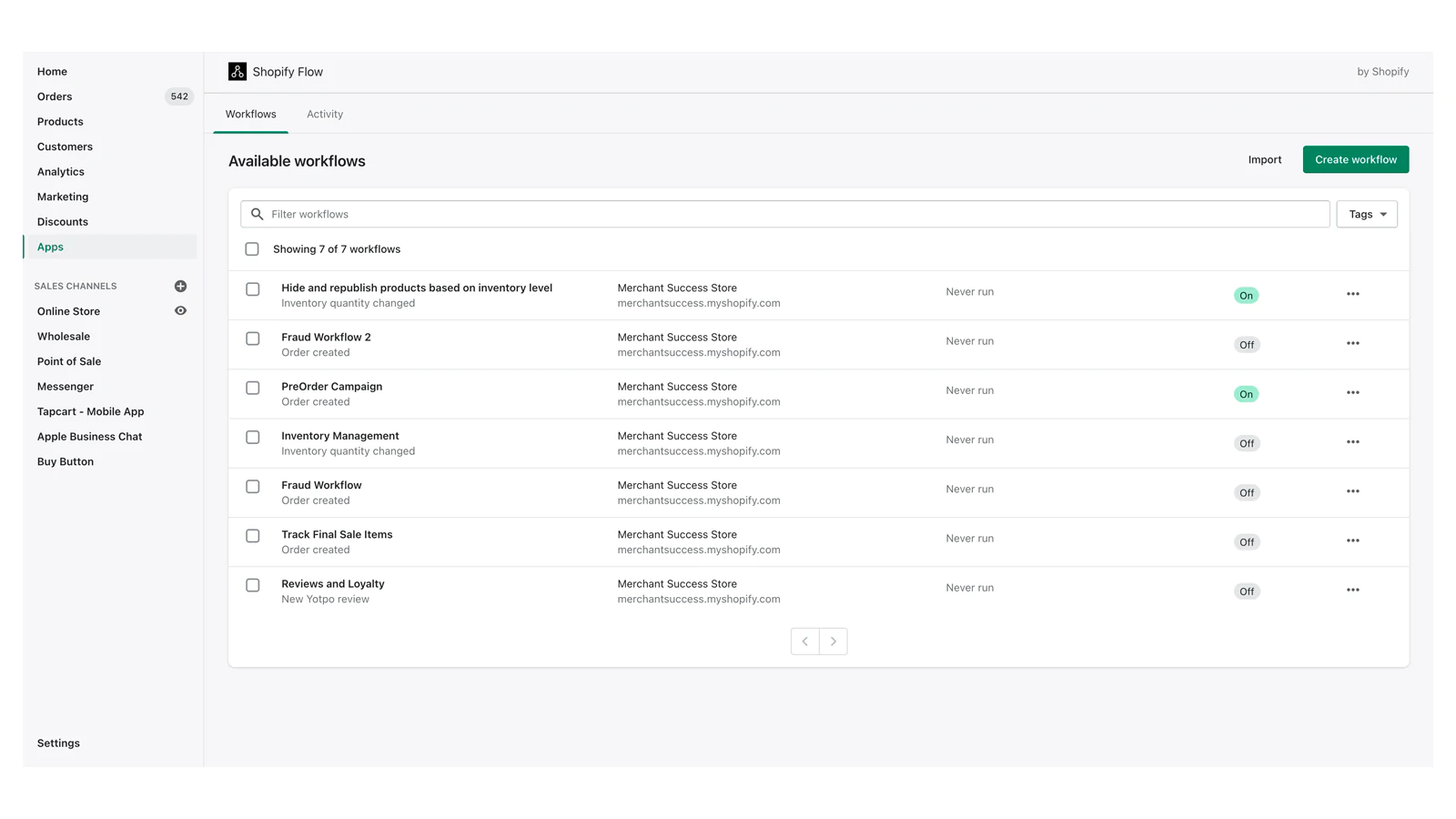
Retain more customers and increase profitability
If you focus all of your attention on acquiring new customers, you could be fighting a losing battle.
Customer acquisition costs are skyrocketing; existing customers are ditching future purchases in favor of a competitor that re-engages them post-purchase.
Use the techniques we’ve outlined here to identify and improve your customer retention rate. From supporting a shared cause to hosting a branded community—don’t let your most valuable customers walk away from future purchases.






